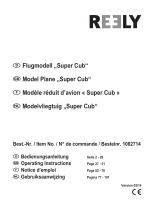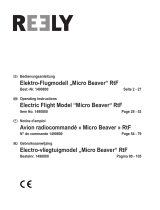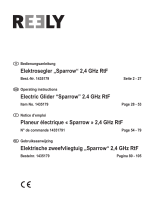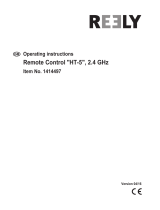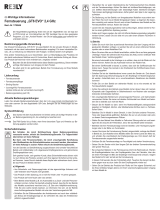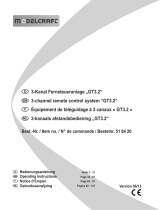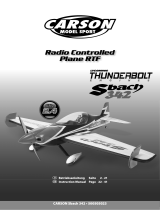Page is loading ...

Bedienungsanleitung
Elektro-Flugmodell „Sky Hawk 2.0“ RtF
Best.-Nr. 1542913 Seite 2 - 29
Operating Instructions
Electric Flight Model “Sky Hawk 2.0“ RtF
Item No. 1542913 Page 30 - 57
Notice d’emploi
Avion radiocommandé « Sky Hawk 2.0 » RtF
N° de commande 1542913 Page 58 - 85
Gebruiksaanwijzing
Electro-vliegtuigmodel „Sky Hawk 2.0“ RtF
Bestelnr. 1542913 Pagina 86 - 113

30
Table of Contents
Page
1. Introduction ........................................................................................................................................................ 32
2. Explanation of Symbols .....................................................................................................................................32
3. Intended Use .....................................................................................................................................................33
4. Product Description ...........................................................................................................................................33
5. Scope of Delivery ...............................................................................................................................................34
6. Safety Notes ......................................................................................................................................................35
a) General ........................................................................................................................................................35
b) Charger ........................................................................................................................................................36
c) Before operation .......................................................................................................................................... 37
d) During Operation .........................................................................................................................................37
7. Information on Batteries and Rechargeable Batteries ....................................................................................... 38
8. Transmitter controls ...........................................................................................................................................39
9. Getting started with the transmitter .................................................................................................................... 40
a) Inserting the Batteries/Rechargeable Batteries ........................................................................................... 40
b) Charging the rechargeable batteries for the transmitter ............................................................................. 40
10. Chargingtheightbattery ..................................................................................................................................41
11. Final Assembly of the Model Airplane ................................................................................................................ 42
a) Assembly of the wings .................................................................................................................................42
b) Mounting the wings ......................................................................................................................................43
c) Mounting the elevator unit ..........................................................................................................................44
d) Mounting the Fin .........................................................................................................................................45
e) Installingtheightaccumulator ..................................................................................................................45
f) Checking the servo settings ........................................................................................................................46
g) Suspending the rudders ..............................................................................................................................47
h) Checking the rudder functions .....................................................................................................................47
i) Checking the engine function ......................................................................................................................50
12. Flying the model ................................................................................................................................................51
a) Testing the Range ........................................................................................................................................51
b) The First Start ..............................................................................................................................................51
c) Spiralling ......................................................................................................................................................51
d) Trimming the Model .................................................................................................................................... 52
e) The First Landing .........................................................................................................................................52

31
Page
13. Binding Function ................................................................................................................................................ 53
14. Care and maintenance ......................................................................................................................................54
a) General Information .....................................................................................................................................54
b) Changing the propeller ................................................................................................................................54
15. Troubleshooting .................................................................................................................................................55
16. Disposal ............................................................................................................................................................. 56
a) Product ........................................................................................................................................................56
b) Batteries/Rechargeable Batteries ................................................................................................................56
17. Declaration of Conformity (DOC) ....................................................................................................................... 56
18. Technical data ....................................................................................................................................................57
a) Model airplane ............................................................................................................................................. 57
b) Transmitter...................................................................................................................................................57
c) Charger ........................................................................................................................................................57

32
1. Introduction
Dear Customer,
thank you for purchasing this product.
This product complies with the statutory national and European requirements.
To maintain this status and to ensure safe operation, you as the user must observe these operating instructions!
These operating instructions are part of this product. They contain important notes on commissioning and
handling. Also consider this if you pass on the product to any third party. Therefore, retain these operating
instructions for reference!
All company names and product names are trademarks of their respective owners. All rights reserved.
If there are any technical questions, please contact:
International: www.conrad.com/contact
United Kingdom: www.conrad-electronic.co.uk/contact
2. Explanation of Symbols
The symbol with a lightning bolt in a triangle is used where there is a health hazard, e.g. from electric shock.
The exclamation mark in a triangle indicates important notes in these operating instructions that must be
observed strictly.
The arrow symbol indicates that special advice and notes on operation are provided.

33
3. Intended Use
This product is an electrically driven model airplane which is radio controlled wireless via the remote control system
includedinthedelivery.Themodelisdesignedforoutdooruseandshouldbeownunderweakwindsorincalm
weather conditions only. The model airplane is pre-assembled and is delivered with built-in remote control and drive
components.
The product must not get damp or wet.
The product is not suitable for children under 14 years of age.
Observe all safety information in these operating instructions. They contain important information on han-
dling of the product.
You are solely responsible for safe operation of the model!
4. Product Description
The model airplane "Sky Hawk 2.0" is a largely pre-assembled RtF model (RtF = "Ready to Fly"). The fuselage, the
wings and tail assembly made of foam or plastic are pre-assembled. All components required for drive and control are
built in the model ready for use.
The model is decorated with a colour decal sheet, which is applied ex works.
The model, which can be controlled via 2 or 3 axes, can be completed easily within a short period of time. The control-
lable features are: Elevator rudder (lateral axis), vertical rudder (elevator) and the speed control of the electric engine.
8 AA/Mignon batteries (e.g. Conrad item no. 652504, pack of 4, order 2x) or 8 AA/Mignon rechargeable batteries are
necessary to operate the transmitter.

34
5. Scope of Delivery
Before you commence assembly, you should check the scope of delivery of your model against the piece
list.
Figure 1
1 Pre-assembled fuselage
2 Elevator rudder
3 Wing halves
4 Vertical rudder
5 Tail unit support incl. attachment screws
6 Screwdriver
7 Wing connection elements incl. attachment screws
8 Remote control transmitter
9 Spare propeller
10 NiMH-ightbattery
11 Plug-in recharging unit
Current operating instructions
Download the current operating instructions via the link www.conrad.com/downloads or scan the
QR code displayed. Observe the instructions on the website.
The spare part list can be found on our website www.conrad.com in the download section for the respective
product. Alternatively, you may also email to request the list of spare parts. For contact information, see the
chapter 1 at the beginning of these operating instructions.

35
6. Safety Notes
In case of damage caused by non-compliance with these operating instructions, the warranty/
guarantee will expire. We do not assume any liability for consequential damage!
We do not assume any liability for property damage or personal injury caused by improper use
or non-compliance with the safety instructions! In such cases the warranty/guarantee is voided.
Normal wear and tear and accidents or damages caused by a crash (e.g. broken propeller or parts
of the plane) are excluded from the guarantee and warrantee.
Dear Customer, this safety information serves not only to protect the product, but also your own safety
and the safety of other persons. Therefore, read this chapter very carefully before taking the product into
operation!
a) General
Caution, important note!
Operating the model may cause damage to property and/or individuals. Therefore, make sure that
you are sufciently insured when using the model, e.g. by taking out private liability insurance.
If you already have private liability insurance, verify whether or not operation of the model is cov-
ered by your insurance before commissioning your model.
Observe: In some countries, you are required to have insurance for any ying models!
• Theunauthorizedconversionand/ormodicationoftheproductisinadmissiblebecauseofsafetyand
approval reasons.
• The product is not a toy and should be kept out of reach of children under 14 years of age!
• The product must not get damp or wet.
• Ifyoudonothavesufcientknowledgeyetashowtodealwithremote-controlledmodels,pleaseseek
the advice of an experienced model sportsman or a model construction club.
• Do not leave packaging material unattended. It may become dangerous playing material for children!
• Should questions arise that are not answered with the help of this operating manual, contact us (contact
information see chapter 1) or another expert.

36
b) Charger
• The charger is constructed pursuant to protection category II. Only a proper mains socket of the public
mains must be used as a voltage source for the charger (for the operating voltage of the charger, see
chapter "Technical Data").
• The socket to which the charger is connected must be easily accessible.
• The charger is only suitable for operation in dry, closed rooms. It must not get moist or wet. Never touch
it with wet hands. There is danger to life from electric shock!
• Do not pull the charger from the mains socket at the cable. Take it at the side of the housing and pull it
from the socket then.
• If the charger is damaged, do not touch it. Danger to life from electric shock!
First switch off the mains voltage for the mains socket to which the charger is connected (switch off the
circuit breaker or turn out the fuse, then switch off the FI protection switch so that the mains socket is
separated from the mains voltage on all poles).
Then unplug the charger from the mains socket. Dispose of the damaged charger in an environmentally
compatibleway.Donotuseitanymore.Replaceitbyanewchargerofthesamespecications.
• Devices that are operated with mains voltage have no place in the hands of children. Therefore, be
particularly careful when children are present. Operate the charger in a way that keeps it out of reach of
children.
• The following unfavourable conditions are to be avoided at the place of operation and during transport:
- Dampness or too high humidity
- Cold or heat, direct solar radiation
- Dustorammablegases,fumesorsolvents
- Strong vibration, impact or blows
- Strongmagneticeldsaspresentnearmachinesorspeakers
• Never use the charger immediately after it hasbeen taken from a cold into a warm environment. The
resulting condensation may destroy the charger, as well as pose danger to life from electric shock! Let
the product reach room temperature before connecting and using it. This may take several hours.
• Observe that the cable of the charger is not bent or crushed.
• Handle the product with care; impacts, shock or fall even from low heights will damage it.

37
c) Before operation
• Check the function safety of your model and of the remote control system. Pay attention to visible dam-
ages such as broken plug-in connections or damaged cables. All movable parts on the model have to be
smooth running; however, there must be no tolerance in the bearing.
• Chargetheightbattery,whichisnecessaryforoperation,aswellastherechargeablebatteryneeded
in the remote control according the instructions indicated by the manufacturer.
• Ifbatteriesareusedforthepowersupplyofthetransmitter,makesurethatthereisasufcientrest
capacity (battery checker). If the batteries are empty, always replace the complete set, never individual
cells only.
• Before each operation, control the settings of the trim slider at the transmitter for different steering direc-
tions and, if necessary, set them.
• Alwaysswitchthetransmitteronrst.Itisonlyafterwardsthatyoumayconnecttheightbatteryofthe
model or switch the model on. Otherwise unexpected reactions of the electric model airplane may occur
and the propeller can start to turn unintentionally!
• Check the correct and secure position of the propeller before each operation.
• Make sure that neither objects nor body parts are in the rotating and suction area of the propeller while
it is rotating.
d) During Operation
• Do not take any risks when operating the product! Your own safety and that of your environment is solely
down to you being responsible when dealing with the model.
• Improper operation can cause serious damage to people and property! Therefore, during operation,
ensureasufcientsafetydistancetopersons,animalsandobjects.
• Select an appropriate site for the operation of your model airplane.
• Flyyourmodelonlyifyourabilitytorespondisunrestricted.Theinuenceoftiredness,alcoholormedi-
cine can cause incorrect responses.
• Do not direct your model towards spectators or towards you.
• Motor,ightcontrolsystemandightbatterycanheatduringoperationofthemodel.Therefore,takea
breakof5-10minutesbeforere-chargingtheightbatteryorbeforere-startingwithapossiblyexisting
spareightbattery.Thedriveenginemustcooldowntoambienttemperature.
• Always leave the remote control (transmitter) turned on, as long as the model is in operation. After land-
ing,alwaysdisconnecttheightbatteryrstorswitchthemodeloff.Itisonlyafterwardsthattheremote
control may be turned off.
• Incaseofafaultoramalfunction,correctthefaultrstthenre-startthemodel.
• Don’t expose your model and the remote control for a longer period of time to direct sunlight or exces-
sive heat.
• Afteruse,theightbatterymustbedisconnectedfromthemodelandthetransmitterswitchedoff.Re-
move the batteries from the transmitter for extended storage.

38
7. Information on Batteries and Rechargeable Batteries
Although use of batteries and rechargeable batteries in everyday life is a matter of course today,
there are many dangers and problems. Therefore, always observe the following information and
safety notes in handling of batteries and rechargeable batteries.
• Keep batteries/rechargeable batteries out of the reach of children.
• Do not leave any batteries/rechargeable batteries lying around openly. There is a risk of batteries being
swallowed by children or pets. If swallowed, consult a doctor immediately!
• Batteries/rechargeablebatteriesmustneverbeshort-circuited,disassembledorthrownintore.There
is a danger of explosion!
• Leaking or damaged batteries/rechargeable batteries can cause chemical burns to skin at contact; there-
fore, use suitable protective gloves.
• Liquids leaking from batteries/rechargeable batteries are chemically highly aggressive. Objects or sur-
faces that come into contact with them may take severe damage. Therefore, keep batteries/recharge-
able batteries in a suitable location.
• Donotrechargenormal,non-rechargeablebatteries.Thereisariskofreandexplosion!Chargeonly
rechargeable batteries intended for this; use suitable chargers.
Batteries (1.5 V) are intended for one-time use only and must be disposed of properly when discharged.
• Always observe the correct polarity when inserting batteries/rechargeable batteries into the transmitter
orconnectingtheightbattery(observeplus/+andminus/-).
Incorrect polarity will damage not only the transmitter but also the plane model and the rechargeable
battery.Thereisadangerofreandexplosion.
• Always replace the whole set of batteries/rechargeable batteries in the transmitter. Do not mix full batter-
ies with half-full ones. Always use batteries/rechargeable batteries of the same type and manufacturer.
• Never mix batteries and storage batteries! Either use batteries or rechargeable batteries for the re-
mote control transmitter. The operation of the remote control (transmitter) with rechargeable batteries
instead of batteries is possible. However, the low voltage (batteries = 1.5 V/cell, rechargeable batteries =
1.2 V/cell) and the lower capacity of rechargeable batteries does lead to a decrease of the operating
time.
• If the device is not used for an extended period of time (e.g. storage), remove the inserted batteries from
the remote control transmitter to avoid damage from leaking batteries.
• Donotleavetherechargeableightbatteryconnectedtotheplanemodelifthelatterisnotused(e.g.
duringtransportorstorage).Otherwise,theightbatterymaybefullydischargedandisthusdestroyed/
unusable!
• Removetheightbatteryfromthemodelplaneforrecharging.
• Neverchargetheightbatteryrightafteruse.Alwaysleavetheightbatterytocooloffrst(atleast
5 - 10 minutes).
• Only charge intact and undamaged batteries. If the outer isolation of the rechargeable battery is dam-
aged or the battery is deformed or bloated, it must not be charged. In this case, there is immediate
dangerofreandexplosion!
• Never leave batteries unattended while charging them.

39
8. Transmitter controls
Figure 2
1 Transmitter aerial
2 LED for the operating voltage display
3 Trim lever for the elevator
4 Control lever for the rudder and elevator
5 Trim lever for the rudder
6 On/off switch
7 Reverse switch (CH1 - CH4) (CH4 without function in this model)
8 Trim lever (without function in this model)
9 Control lever for the motor function
10 Trim lever for the motor function
11 LED for function display
12 Carrying handle

40
9. Getting started with the transmitter
Intheoperatinginstructions,thenumbersinthetextalwaysrefertothegureoppositeorthegureswithin
thesection.Crossreferencestootherguresareindicatedwiththerespectivegurenumber.
a) Inserting the Batteries/Rechargeable Batteries
For the power supply of the transmitter you will need 8
alkaline batteries (e.g. Conrad item no. 652504, pack of
4, order 2x) or rechargeable batteries AA/mignon size. For
ecological and also for economical reasons it is recom-
mended to use rechargeable batteries, since they can be
recharged.
To insert the batteries or rechargeable batteries,
proceed as follows:
• The battery compartment lid (1) is located on the rear
side of the transmitter. Please press the corrugated tri-
angle and push off the lid downward.
• Now insert the 8 batteries or rechargeable batteries in
the battery compartment. Observe the correct polarity of
the individual cells. A corresponding note (3) is located
on the bottom of the battery compartment.
• Afterwards slide the lid of the battery compartment back
on from the bottom and let the locking mechanism click
into place.
b) Charging the rechargeable batteries for the transmitter
If you use 8 AA/mignon rechargeable batteries for your transmitter, take these out of the transmitter for charging and
recharge them in a suitable round cell charger.
Observe the instructions of the charger‘s manufacturer as well as the technical data sheets of the used accumulators.
Nevertrytorechargebatteries(1.5V/cell)withacharger;dangerofexplosionandofre!
Warning!
Theightcontrolsysteminthemodelisequippedwithaneffectiveprotectivecircuitwhichlaterprevents
the unintentional startup of the drive motor.
Nevertheless, before using the transmitter, always make sure that the motor function control stick (see
gure2,pos.9)isinthe"motoroff"position.Forthis,thecontrollevermustbepushedallthewaytothe
bottom-most position.
In contrast to control of the rudder and elevator, where the control lever will always return to the middle
position by spring force, the control lever for the motor function always remains in the position in which it
was put last.
Figure 4
Figure 3

41
When new batteries or freshly charged rechargeable batteries have been inserted, switch on the transmitter with the
functionswitch(seegure2,pos.6)fortestpurposes.Theredandgreenlightdiode(seegure2,pos.2and11)light
upandsignalthatwaythatthetransmitterissufcientlysuppliedwithpower.
Ifthepowersupplyisnolongersufcientforproperoperationofthetransmitter(below8.3V),theredlightdiode(see
gure2,pos.11)startstoash.Inthiscase,stopoperationofyourmodelasquicklyaspossible.
For further operation of the transmitter the rechargeable batteries have to be recharged or new batteries have to be
inserted.
In order to avoid the memory effect of NiCd rechargeable batteries, you should connect a charger only when the
rechargeable batteries are completely discharged.
10. Charging the ight battery
• Before the nal assembly of the model, you should
chargetheightbattery(1).Anappropriateplug-inbat-
tery charger (2) is included in the delivery.
• Connect the ight battery with the connector that is
protected against polarity reversal (3) of the plug-in
charger. The catch (4) on the charger plug must arrest
in the groove of the accumulator plug.
• Then connect the plug-in charger to a mains socket.
For photo-technical reasons, the charging ca-
ble of the plug-in mains unit is illustrated in the
wound-upstate.Beforetherstuse,thecable
retainer should be opened and the cable be un-
wound.
Important!
The charging process is completed after approx. 4 to 5 hours. After that, the rechargeable battery has to be
disconnected from the battery charger and the battery charger disconnected from the mains socket.
If the rechargeable battery is only partly discharged, the charging process must be stopped earlier. For
that purpose, check the temperature of the rechargeable battery manually in regular intervals. Once the re-
chargeable battery is completely charged, the charging current is completely transformed into heat. Thus,
the temperature of the rechargeable battery increases noticeably.
Figure 5

42
11. Final Assembly of the Model Airplane
Before starting with the assembly of the model, you should ensure an appropriate surface
In order to attain excellent airplane performances, your model is manufactured with a light plastic foam. However, this
is very sensitive. Small mistakes during assembly of the model quickly lead to unsightly bumps or even holes in the
surface. Therefore, handle the model with care.
a) Assembly of the wings
• Putbothwinghalvesushtogether(1)andthenattach
the top wing connection element (2).
• Then turn the wings around so that the top side faces
downwards and then attach the bottom wing connection
element (3) according to the illustration.
Make sure that the borings fort he attachment screws
areushwitheachother.
• Now screw the bottom wing connection element togeth-
er with the top element using the enclosed 2.6 x 8 mm
attachment screws (4).
Figure 6

43
b) Mounting the wings
• Place the wing on the fuselage and slide the two attach-
ment bolts (1) into the prepared openings in the fuse-
lage.
• Align the surface at a right angle to the fuselage. The two
distances A must have the same length.
• Afterwards, the wing is attached on the front with a 2.6 x
21 mm screw (3) and on the rear with two 2.6 x 16 mm
screws (4) on the fuselage.
Figure 7

44
c) Mounting the elevator unit
• First pull off the protective foil of the double adhesive
tape on the bottom of the elevator unit (1) and on the
bottom of the unit support (2).
• First, only attach the elevator unit lightly to the end of
the fuselage so you can still adjust it. The borings in the
elevator unit must match exactly with the borings in the
fuselage, and the two distances B must also have the
same length.
• Once the fuselage is exactly adjusted, plug it into the
unit support (3) from above through the two borings and
screw it tight from the bottom with the two 2.0 x 8 mm
screws.
• With correct design, the elevator unit must be aligned
parallel to the wing (see sketch on the side).
In case of slight deviation, loosen the screws on the unit
support, place a thin strip of cardboard between the unit
and fuselage and tighten the screws again.
Figure 8

45
d) Mounting the Fin
• Then(1)isslidfromaboveintotheunitholderand
aligned.
• Therearedgeofthendampenermustbeushwith
the rear edge of the elevator unit damping surface (see
broken line).
Important!
Then(1)mustalsobeata90°angletothe
elevator unit (3) (see sketch).
• Oncethenisexactlyaligned,attachitfromtheleftside
with the two 2 x 10 mm screws (2).
e) Installing the ight accumulator
• Youhavetotakeoffthecabinhood(1)toinserttheight
accumulator. To do so, press the latch (2) forward and
lift the hood off forward on the rear.
• The hood is maintained in place in the front by another
latch that snaps in beneath the fuselage wall. When
puttingonthehood,yoursthavetoslideinthecatch
beneath the side wall of the fuselage before securing the
hood again with the front latch.
• Prior to connecting the accumulator to the model, you
have to check whether the function switch on the model
(3) is in the rear position (OFF).
• Insertthechargedightbattery(4)intothebatterycom-
partment and connect it with the plug-type connection
(5)oftheightcontrol.
• Onceagain,thelatchesoftheightcontrolplugmust
engage in the groove of the accumulator plug the same
way as with connection to the charger.
Figure 9
Figure 10

46
Our tip:
Generally,itisnotrequiredtoadditionallysecuretheightbatteryinthemodel,becausethebatteryis
retainedbythefuselageparts.Iftheseclampsslackenoverthecourseoftime,youcanattachtheight
battery with a bit of Velcro tape or rubber rings.
f) Checking the servo settings
Toensurethattheruddershavethesamedeectiononbothsides,theservoleversmustbeata90°angletothe
control rods. You have to dismount the wing to check the correct position of the servo levers.
Thenputthetransmitterintooperationandthenswitchonthereceiverinstallation(seegure10,pos.3)withthe
function switch.
Onceyouturnonthereceiverinstallation,thedriveengineisnotyetreadyforoperation.Youcanrststart
theenginewhenthesafetybuttonispushedwhilethereceiverinstallationison(seegure10,pos.6).
Slidethetrimsliderfortheelevatorandnunit(seegure
2, pos. 3 and 5) into central position and check the correct
position of the servo levers.
Both cross-shaped servo levers (1) must be aligned in
such a way that the control lever is at an exact 90° angle
to the control rods (2).
Slight deviations can be corrected with the trim sliders on
the transmitter.
In case of larger deviations, loosen the screw on the servo
lever (3), pull the lever upwards and attach it again shifted
by one "tooth".
Once the position of the servo lever is right, screw in the
attachment screw again.
Figure 11

47
g) Suspending the rudders
• After you have checked resp. adjusted the correct posi-
tion of the servo levers, you can now suspend the fork
heads (1) of the control rods each in the center boring of
the rudder horns (2).
• Now check whether the rudders are exactly in the cen-
tral position while the transmitter and receiver unit is
turned on.
Therudder(3)mayneitherdeecttotheleftortheright
and the elevator unit (4) may not point upwards or down-
wards(alsoseegure13).
• In case of deviation from the central position, you can
change the total length of the control by twisting the fork
headsandexactlyaligntherudderap.
Warning!
Make sure to turn the receiver system off in all cases before performing adjustment work on the control
rods.
Practical tips:
Youcanbestseeaslantoftherudderapsofyoulookatthemodelfrombehindatadistance.
h) Checking the rudder functions
• First start running the transmitter then the model. The safety button for the motor function may not be operated to
prevent accidental start-up.
• Ifthecontrolleverfortherudderandelevator(seegure2,pos.4),andtheassociatedtrimlevers(seegure2,
pos.3and5)areinthemiddlepositions,therudder(seegure13,pos.1)andelevator(seegure13,pos.2)are
to be aligned precisely centred as well.
Figure 13
Figure 12

48
• Ifyoupullthecontrolleverfortherudderandelevatorfunctions(seegure2,pos.4)down,theelevatormust
deecttothetop.Inight,thelandinggearispresseddownwardsandthemodelascends.
• If the elevator reacts opposite to the function described above, you may change the direction of the elevator servo
withthereverseswitch(seegure2,pos.7).Thereisaseparateswitchforeachcontrolchannel.Theelevator
direction is switched with the 2nd switch from the left (CH2).
Figure 14
• Ifyoupushthecontrolleverfortherudderandelevatorfunctions(seegure2,pos.4)up,theelevatormustdeect
downwards.Inight,thelandinggearisthenpressedupwardsandthemodeldescends.
• This control function is required to put the model into a normal light position if it wants to ascend too much due to
a control error or a gust of wind.
Figure 15
/

